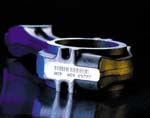Getting A Read On 3D Bar Codes
Bar coding of manufactured parts holds the promise of improved process control and inventory control. However, the familiar gummed paper label (with black bars on a white background) simply could not withstand the coolant spray, cleaning solutions, heat treating and other harsh processes that metal parts routinely undergo.
In the last few years, the manufacturing sector has been seeking ways to utilize bar coding to achieve some of the efficiencies already enjoyed by such areas as shipping and retail sales. Bar coding of manufactured parts holds the promise of improved process control and inventory control. However, the familiar gummed paper label (with black bars on a white background) simply could not withstand the coolant spray, cleaning solutions, heat treating and other harsh processes that metal parts routinely undergo. The bar code might be applied directly to the part instead of to a label, however doing so usually does not provide enough contrast to permit a conventional bar code scanner to read the code. Now, however, both obstacles to bar coding manufactured parts may have been overcome by a system that combines an integral, three-dimensional bar code with a laser bar code scanning device.
“Until recently, bar coding has been primarily a paperbased labeling system used to identify relatively large batches of an item,” explains Ray Speicher, vice president of TraceAbility Systems (Ingomar, Pennsylvania). “The industry is moving into a new phase, as is evidenced by recent initiatives in the auto and aerospace industries, where the goal is direct marking of parts with machine-readable code to permit automated tracking of parts, collection of data on the manufacturing process itself and inventory control of finished goods.
“Manufacturers must be able to identify individual parts,” Mr. Speicher continues. “They can no longer afford to simply identify batches. Continuing to do so means continuing to incur expensive and sometimes massive recalls of cars, refrigerators, tires, etc., because there is no way of determining whether a particular problem affected just a few parts or the entire day’s production.”
TraceAbility Systems’ solution to the problem is a “Bumpy Bar Code,” a three-dimensional bar code that is an integral feature of the part. The bar code can be either raised from or impressed in the surface of the part. It can be integrally cast or molded in the part, or it can be indented, peened, etched, stamped, machined or otherwise impressed in the part. Additionally, metal tags that have been Bumpy Bar Coded can be supplied for attachment to parts or pallets.
A Bumpy Bar Code Reader, like the fixed-mount model shown above, illuminates the bar code target with a laser, capturing the reflected image in a two-dimensional closed coupled device (CCD). The angular displacement between the laser and CCD array allows detection of the differences in height across the Bumpy Bar Code. Once captured by the CCD array, the reflected image is digitized and processed by an onboard Digital Signal Processor. The BBC process requires no contrast of color, therefore parts can often be scanned even though they have been painted.
The Bumpy Bar Code Reader is available in handheld (Model 1010 and 1410) and in fixed mount versions (Model F1010 and F1410). Model selection depends on such considerations as product material, width and depth of bar code, marking and read range requirements. The BBC Readers permit work in process data collection, parts tracking and error proofing in environments in which black and white bar coding techniques are ineffective; however, they can also be used to read conventional bar codes.
Parts can be individually bar coded in a number of ways. For example, Mr. Speicher reports that a manufacturer of hydrostatic transmissions for small, off-road vehicles machines transmission components in a machining center. While the parts are being processed, a small, separate milling head attachment etches a unique Bumpy Bar Code in each. Other companies, such as John Deere, Caterpillar and Siemens, are indent marking bar codes and alphanumeric characters on metal components using compact, pneumatic, pin marking systems made by Mecco Marking Products and available through TraceAbility Systems.
Mr. Speicher expects that adoption of bar coding standards by the automotive and aircraft/aerospace industries will result in numerous Bumpy Bar Code applications by the manufacturers and their vendors. He encourages companies exploring 3D bar coding applications to consider a systems approach. “Planning should include not only the best method for imparting the bar code to the part, but also where on the assembly line to position the bar code readers,” he stresses. “Bar codes should be added to parts as early in the process as possible so that they can be used to identify problems as quickly as possible and help discover the causes.”
Read Next
The Cut Scene: The Finer Details of Large-Format Machining
Small details and features can have an outsized impact on large parts, such as Barbco’s collapsible utility drill head.
Read More3 Mistakes That Cause CNC Programs to Fail
Despite enhancements to manufacturing technology, there are still issues today that can cause programs to fail. These failures can cause lost time, scrapped parts, damaged machines and even injured operators.
Read More










.png;maxWidth=300;quality=90)










